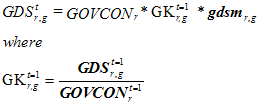International Futures Help System
Policy Equations Government Expenditures
The fiscal model of IFs is quite simple and builds on the computation of government consumption (GOVCON) in the economic model.
IFs expenditures fall into six categories: military, health, education, research and development, other, and foreign aid. IFs divides total government consumption (GOVCON) into these five destination sectors (GDS) with a vector of government spending coefficients (GK) based on initial conditions. The user can change that default pattern of government spending over time with a multiplier parameter (gdsm). The model normalizes the allocation to assure that the money spent is no more or less than total government consumption.
The last category of spending complicates the allocation of spending to destination categories. It is traditional not to think of foreign aid in terms of its percentage of the governmental budget (as we often think of defense or educational expenditures), but to think of it in terms of a percentage of the GDP. For instance, the United Nations has called for foreign aid spending equal to 0.7% (earlier 1.0%) of GDP of donor countries. Moreover, for some governments, foreign aid is not an expenditure, but a receipt and an addition to government revenues.
Therefore IFs actually calculates foreign aid expenditures and receipts first and fixes those amounts (see the foreign aid equations). It then allocates the amount of government spending that remains in the coffers of aid donors (or the augmented amount available to aid recipients) among the other categories, normalizing the allocation to the sum of the coefficients in those other categories.

There are several forward linkages of government spending that are important. A mortality multiplier (MORTMG) is computed for the demographic model, using changes in health spending from the initial year and a parameter of the impact of that spending (elashc).

Three of the forward linkages carry information on spending to the calculation of multifactor productivity in the economic production function, for additive rather than multiplicative use. One variable tracks change in education spending (CNGEDUC), modified by an elasticity of education on MFP (elmfped) and carries it forward. Another tracks changes in health spending (CNGHLTH) using a parameter (elmfphl). The third tracks changes in R&D spending with a parameter of impact (elmfprd). In each case there is a lag involved because of computational sequence.



Because essentially of an older variable form for the education term that is still used in the agricultural model’s production function, the first of the three terms is transferred to that older variable (LEFMG).
![]()
 International Futures at the Pardee Center
International Futures at the Pardee Center